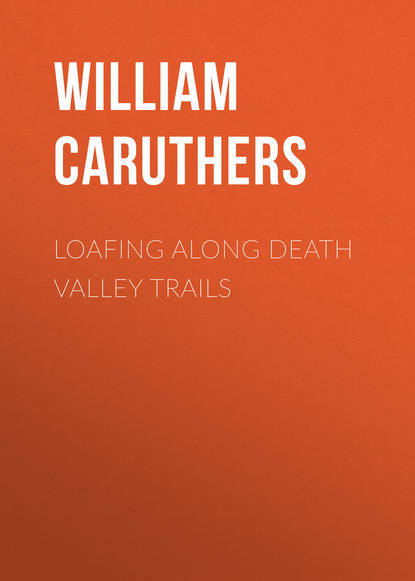По всем вопросам обращайтесь на: info@litportal.ru
(©) 2003-2024.
✖
Loafing Along Death Valley Trails
Настройки чтения
Размер шрифта
Высота строк
Поля
“Say, fellow – ” the tourist barked. “Senator Brown is a friend of mine. Get a move on or you’ll be looking for a job.”
Without the flicker of an eyelid, Charlie quickened, jumped for a cleaning rag and briskly polished the windshield. When he brought the tourist’s change he apologized for his slowness and begged him not to report it to Senator Brown. “Jobs are hard to get and I have a wife and ten children to support.”
Touched with remorse, the tourist looked at the change. “Just give it to the kids and forget it.”
When the Pacific Coast Borax Company built its swanky Furnace Creek Inn on the western slope of the Funeral Range overlooking Death Valley, it began to look about for places that would give the most spectacular and comprehensive view of the Big Sink as a means of entertaining guests, and far enough away to keep them from boredom.
All the old timers who had wandered over the ranges were called in. Each suggested the place that had impressed him more than others. Each of these places was visited and after weeks of deliberation a spot on Chloride Cliff toward the northern end of Death Valley was chosen and the bigwigs started back to Los Angeles.
When they stopped at Shoshone for gas and water, Clarence Rasor, an engineer of the company was still thinking of the chosen site and asked Brown, long his friend, if he knew of any view of the valley better than the one at Chloride Cliff.
“I don’t pay much attention to scenery,” he told Rasor. “To me it’s all just desert or mountain. But I know one view that made me stop and look. Kinda got me. The chances are most folks would rave over it.”
“Could you find it?”
“Sure could…”
Rasor called the others, repeated Charlie’s story and added: “You’re in a hurry, but knowing Charlie as I do, I believe we’d better turn around and go back if he’ll guide us.”
Charlie agreed. It was a long, tortuous climb, even to the base of the peak. There Charlie went ahead and then beckoned them. Holding to bushes they walked or crawled to stand beside him; took one look and caught their breath. A mile below them lay the awesome Sink. White salt beds spread like a shroud over its silent desolation. Billowed dunes, gold against the dark of lava rock. Here a pastelled hill. There a brooding canyon. Beyond, the colorful Panamint under the golden glow of the sun.
“This is the place,” they said.
“… You can tell ’em too,” said Charlie pointing, “that right down there is Copper Canyon. If such stuff interests them, they can see the footprints of the camels and elephants and a lot of historic junk like that.”
So you who thrill at Dante’s View may thank Charles Brown of Shoshone.
When first elected to the senate, his colleagues were quick to see the qualities that had appealed to voters when they elected him supervisor. He had frequently been before that body in his fight for roads and tax reforms. They knew too that better schools for all rural areas either wholly or largely were the result of his efforts, and soon he was on the Rules Committee – a place usually assigned to those who come from the more populous districts of the state, because its five members through its power to appoint all standing and special committees, largely decide what legislation reaches the governor.
In 1950 Brown announced his candidacy for reelection under the state law that enables a candidate to seek the nomination of two parties.
The slot machine had been outlawed in California by the previous legislature and Brown had been largely instrumental in securing the passage of the law. Since the slot machine is a three billion dollar business in the nation, the gamblers opposed him as part of a general plan to secure repeal of the law and reinstate the one-arm bandits.
Since Mono county adjoins Nevada, gambling interests of that state contributed without stint, to retire Brown to private life. He had been in office for 25 years and opposed by this powerful group, guided by both brains and cunning, the odds apparently were against him. While the opposition boasted that he was through, Brown was calling at cabins in the hills and gulches, meeting friends on busy village streets and again when the vote was counted, it was discovered that voters have memories. He had won the nomination of both the Democratic and Republican parties by almost two to one and under the law, was re-elected.
Due to his priority standing and the retirement of older senators, the big fellow who walked 150 miles to get a job at Greenwater in order to save the fare to eat on, automatically shares with two men the power to control the legislation of the state.
Hell, like gold, is where you find it – either in people or places. A lady of wealth and aristocratic background in route to Furnace Creek’s luxury inn, stopped at Shoshone for gas. Worn out by the long drive over the corduroy road, she looked about her and then at Charlie in greasy overalls. “How on earth,” she asked in genuine distress, “do you make a living in this God-forsaken-hole?”
“It’s hard ma’am,” Charlie said gloomily. “But we get a few pennies from tourists, a little flour from mesquite beans, and stay alive one way or another, hoping to get out.”
The gracious lady opened her purse, thrust a five dollar bill into Charlie’s hand and went her way.
“It really made her happy,” Charlie chuckled, “and I just didn’t have the heart to give it back.”
What is it that man wants of these “God-forsaken-holes” on the desert? I sought the answer one day when Shoshone was having a holiday. George Ishmael, as native as an Indian, was chosen to barbecue the steer. A well-to-do tourist begged the job of digging the big pit. “Want to flex my muscles…” Another cut the wood. At a depth of four feet, water was struck and rose a foot over the bottom. “That’s all right” George said. He tossed a dozen railroad ties into the hole, floated them into position, covered them with dirt, built the fire, lowered the carcass of the steer, covered it with green leaves and filled the hole. “An unforgettable feast,” agreed the scores who had come from places 100 miles away.
Sitting beside me was a prominent Los Angeles attorney, eminent in the councils of the Democratic party in both state and nation. “Why,” he asked, “will a man wear himself out in the city when he can really live in a little place like this?”
“I thought of suicide at first,” said Patsy, young matron with three healthy little stairsteps. “My husband said ‘for heaven’s sake, go out for a month and have a good time.’ I went. Back in a week.”
A Vermont girl said she had come to escape a straightlaced code that constantly reminded her sin was everywhere. “Here I’ve got an even break with the devil…”
All had found something that clicked with something inside of them which challenged something in civilization. Maybe it was expressed in the dogma of the Tennessee judge reared in the hill country of the Cumberland river. As he stepped from his plane on his annual vacation he was cornered by a reporter: “Judge, you’re 94 years old. What do you think of this modern world?”
“Best one I know about.”
“No criticism?”
“None whatever. Maybe a few minor changes. Just now we are being educated out of common sense into ignorance; lawed out of patriotism; taxed into poverty; doctored to death and preached to hell…”
Chapter XXII
Lost Mines. The Breyfogle and Others
The most famous lost mine in the Death Valley area is the Lost Breyfogle. There are many versions of the legend, but all agree that somewhere in the bowels of those rugged mountains is a colossal mass of gold, which Jacob Breyfogle found and lost.
Jacob Breyfogle was a prospector who roamed the country around Pioche and Austin, Nevada, with infrequent excursions into the Death valley area. He traveled alone.
Indian George, Hungry Bill, and Panamint Tom saw Breyfogle several times in the country around Stovepipe Wells, but they could never trace him to his claim. When followed, George said, Breyfogle would step off the trail and completely disappear. Once George told me about trailing him into the Funeral Range. He pointed to the bare mountain. “Him there, me see. Pretty quick – ” He paused, puckered his lips. “Whoop – no see.”
Breyfogle left a crude map of his course. All lost mines must have a map. Conspicuous on this map are the Death Valley Buttes which are landmarks. Because he was seen so much here, it was assumed that his operations were in the low foothills. I have seen a rough copy of this map made from the original in possession of “Wildrose” Frank Kennedy’s squaw, Lizzie.
Breyfogle presumably coming from his mine, was accosted near Stovepipe Wells by Panamint Tom, Hungry Bill, and a young buck related to them, known as Johnny. Hungry Bill, from habit, begged for food. Breyfogle refused, explaining that he had but a morsel and several hard days’ journey before him. On his burro he had a small sack of ore. When Breyfogle left, Hungry Bill said, “Him no good.”
Incited by Hungry Bill and possible loot, the Indians followed Breyfogle for three or four days across the range. Hungry Bill stopped en route, sent the younger Indians ahead. At Stump Springs east of Shoshone, Breyfogle was eating his dinner when the Indians sneaked out of the brush and scalped him, took what they wished of his possessions and left him for dead.
Ash Meadows Charlie, a chief of the Indians in that area confided to Herman Jones that he had witnessed this assault. This happened on the Yundt Ranch, or as it is better known, the Manse Ranch. Yundt and Aaron Winters accidentally came upon Breyfogle unconscious on the ground. The scalp wound was fly-blown. They had a mule team and light wagon and hurried to San Bernardino with the wounded man. The ore, a chocolate quartz, was thrown into the wagon.
“I saw some of it at Phi Lee’s home, the Resting Spring Ranch,” Shorty Harris said. “It was the richest ore I ever saw. Fifty pounds yielded nearly $6000.”
Breyfogle recovered, but thereafter was regarded as slightly “off.” He returned to Austin, Nevada, and the story followed.
Wildrose (Frank) Kennedy, an experienced mining man obtained a copy of Breyfogle’s map and combed the country around the buttes in an effort to locate the mine. Kennedy had the aid of the Indians and was able to obtain, through his squaw Lizzie, such information as Indians had about the going and coming of the elusive Breyfogle.
“Some believe the ore came from around Daylight Springs,” Shorty said, “but old Lizzie’s map had no mark to indicate Daylight Springs. But it does show the buttes and the only buttes in Death Valley are those above Stovepipe Wells.
“Kennedy interested Henry E. Findley, an old time Colorado sheriff and Clarence Nyman, for years a prospector for Coleman and Smith (the Pacific Borax Company). They induced Mat Cullen, a rich Salt Lake mining man, to leave his business and come out. They made three trips into the valley, looking for that gold. It’s there somewhere.”
At Austin, Breyfogle was outfitted several times to relocate the property, but when he reached the lower elevation of the valley, he seemed to suffer some aberration which would end the trip. His last grubstaker was not so considerate. He told Breyfogle that if he didn’t find the mine promptly he’d make a sieve of him and was about to do it when a companion named Atchison intervened and saved his life. Shortly afterward, Breyfogle died from the old wound.
Indian George, repeating a story told him by Panamint Tom, once told me that Tom had traced Breyfogle to the mine and after Breyfogle’s death went back and secured some of the ore. Tom guarded his secret. He covered the opening with stone and leaving, walked backwards, obliterating his tracks with a greasewood brush. Later when Tom returned prepared to get the gold he found that a cloudburst had filled the canyon with boulders, gravel and silt, removing every landmark and Breyfogle’s mine was lost again.
“Some day maybe,” George said, “big rain come and wash um out.”
Among the freighters of the early days was John Delameter who believed the Breyfogle was in the lower Panamint. Delameter operated a 20 mule team freighting service between Daggett and points in both Death Valley and Panamint Valley. He told me that he found Breyfogle down in the road about twenty-eight miles south of Ballarat with a wound in his leg. Breyfogle had come into the Panamint from Pioche, Nevada, and said he had been attacked by Indians, his horses stolen, while working on his claim which he located merely with a gesture toward the mountains.
Subsequently Delameter made several vain efforts to locate the property, but like most lost mines it continues to be lost. But for years it was good bait for a grubstake and served both the convincing liar and the honest prospector.







